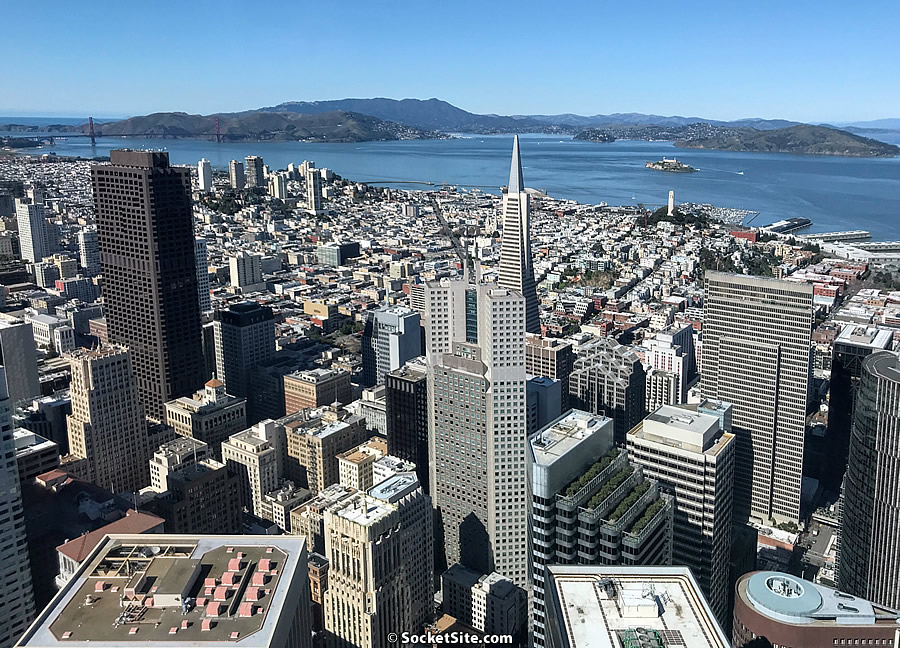The weighted average asking rent for an apartment in San Francisco ticked back up a (1) percent in April to $3,450 a month which is 13 percent higher than at the same time last year.
That being said, the average asking rent in San Francisco is still 16 percent ($650) lower than prior to the pandemic and 23 percent ($1,025) below San Francisco’s 2015-era peak, with the recovery for two-bedroom units, the average asking rent for which had dropped to around $3,500 early last year and has since ticked back up to around $4,000 a month, outpacing the recovery for both larger and smaller units but still 10 percent below pre-pandemic levels and 20 percent below peak.
At the same time, the number of apartments listed for rent in the city, which peaked in the fourth quarter of 2020 and has since been ticking down, inched down a percent in April and is now around 5 percent lower than pre-pandemic levels but with 12,000 fewer people in the labor force and 13,000 fewer people employed, none of which should catch any plugged-in readers by surprise.
Our analysis of the San Francisco market is based on over 150,000 data points going back to 2004 that we maintain, normalize and index on a monthly basis. We’ll keep you posted and plugged-in.

As others have mentioned, with inflation soaring, rents in a steady state or even up a handful of percent represent a gain for renters given the decrease in real purchasing power of every dollar exchanged for housing.
So…. good news here?
As long as the renter’s income is increasing faster than inflation, then they are “winning”. That isn’t usually the case (not referring to rent-controlled units, here). Most W-2 workers have to ask for wage increases *after* the inflation has happened.
SF’s rent recovery has been sluggish compared to many other cities. It’s a major reason why new residential development proposals have come to a virtual standstill in the City.
Per today’s Chronicle: “The flow of applications coming into the San Francisco Planning Department for new housing developments has slowed in 2022 with just three projects totaling 62 units processed so far this year — something developers and construction leaders say is a reality of high construction costs, inflation, rising interest rates and a slow pandemic recovery.”
It’s impacting approved projects as well. Brookfield has delayed the start of Phase 1 of its Pier 70 development for at least a year. It failed to exercise an option to take possession of Phase 1 parcels after an appraisal came in low. There will be other appraisals this year and if they too come in low the project will be further delayed. Brookfield cited the viability of “vertical construction” as a reason for the delay.
I’m pretty sure that high construction costs, inflation, and rising interest rates are factors in other markets (and countries). Apartment rents and home prices in San Francisco are already among the highest in the U.S. Supply chain issues are a major factor right now in the construction industry, which affects construction in the near-term but not the longer-term.
Vertical construction carries more risk than low-rise building due to the inability to build in phases. The entire tower must be built at once. If a developer is concerned about a recession or rising interest rates affecting the rate of sellout, that *does* affect the viability of vertical development in the near-term. Again, San Francisco is not alone in susceptibility to high interest rates or the possibility of a FED-induced recession.
Brookfield has already pivoted on the office space portion of Pier 70. 2.3 million more feet of office space is not needed in SF and won’t be for a long while. They are positioning to build out much of the office component as life science space.
The issues affect not just SF but the impact is greater here. Construction costs are among the highest in the world Still, major new office and housing development is being proposed in the North Peninsula just across the county line.
you get some wide leeway from the editor.
Why is it that SF rents posts get a blue-skyed view of Transamerica, BofA, Mt Tam and points yonder while Oakland rents posts gets the same tired, weird whatever-it-is? Can you get an Oakland glam shot next time?
Uh, what would you have the Oakland glam shot feature? The Tribune Tower? What is that, twenty storys? The Grand Lake Theater? Inquiring minds want to know.
The shots are very similar: panoramas of the downtown areas. The DTSF one is a glam shot while the DTO one features BOC (“Buildings of Color”) which, I suppose, reflects how people view each…rightly or wrongly. (And BTW, the tradtional “glam shot” for Oakland would be a panorama looking west over Lake Merritt toward the skyline)
When wages go up landlords use it as an excuse to raise rents proportionally putting us right back to where we were. We need to make it mandatory that future construction of apartment buildings must each have a number of rental units of 300 square feet or less that cannot rent for more that 40 hours net at minimum wage, this will enable everybody to afford a place to live. A cap of +25% should allow for people to transition to market rate housing.
Each year the landlord [could] request a W2 to verify eligibility. This would also benefit fixed income retirees and the disabled. Make it mandatory that future construction of apartment buildings must each have a number of these units directed by the local permitting authority. Thus insuring availability and allowing for growth of the community.
I can’t tell whether you are being serious or not with those last 3 sentences. Please use a winking emoji or something in the future.
Except that landlords don’t use “wages” to set rents. Landlords use recent nearby comparable lease values.
The correct term is “housing providers,” the city of San Francisco is the landlord!